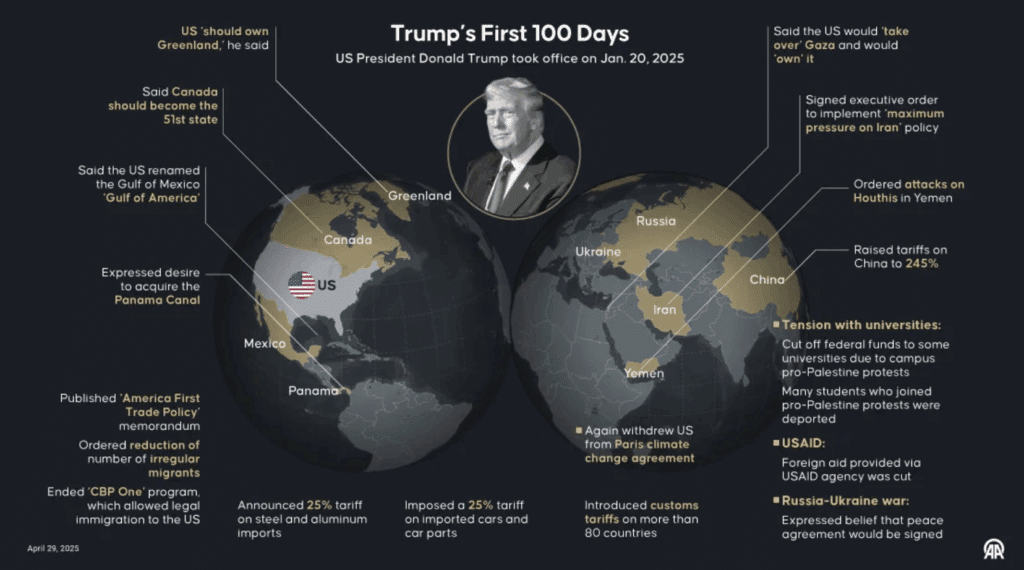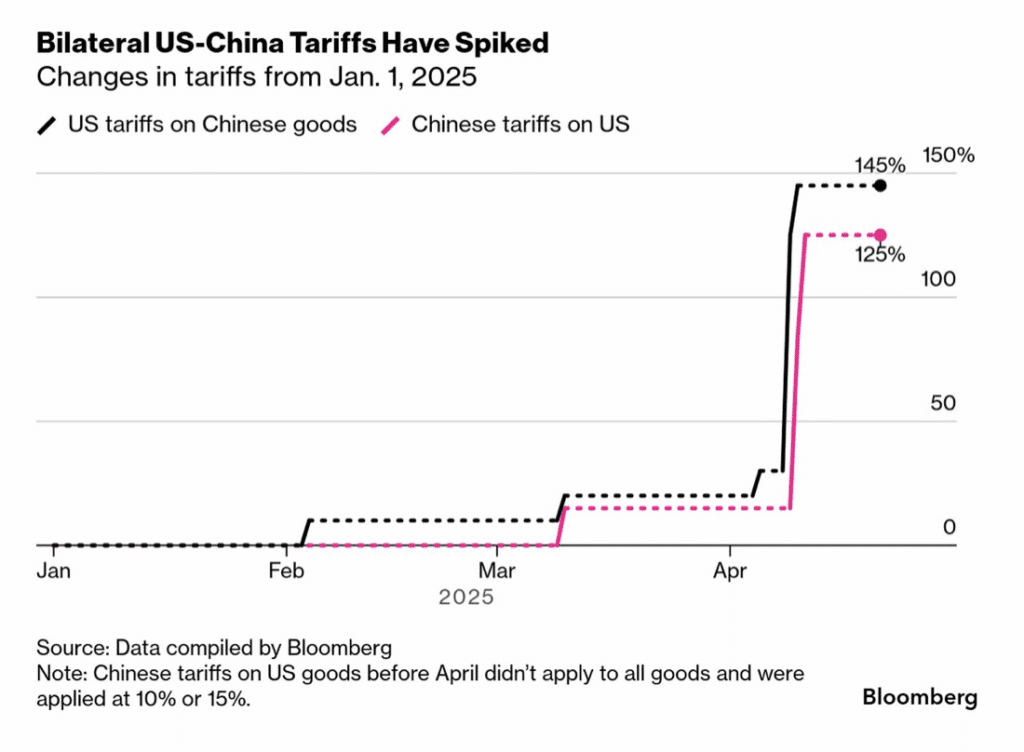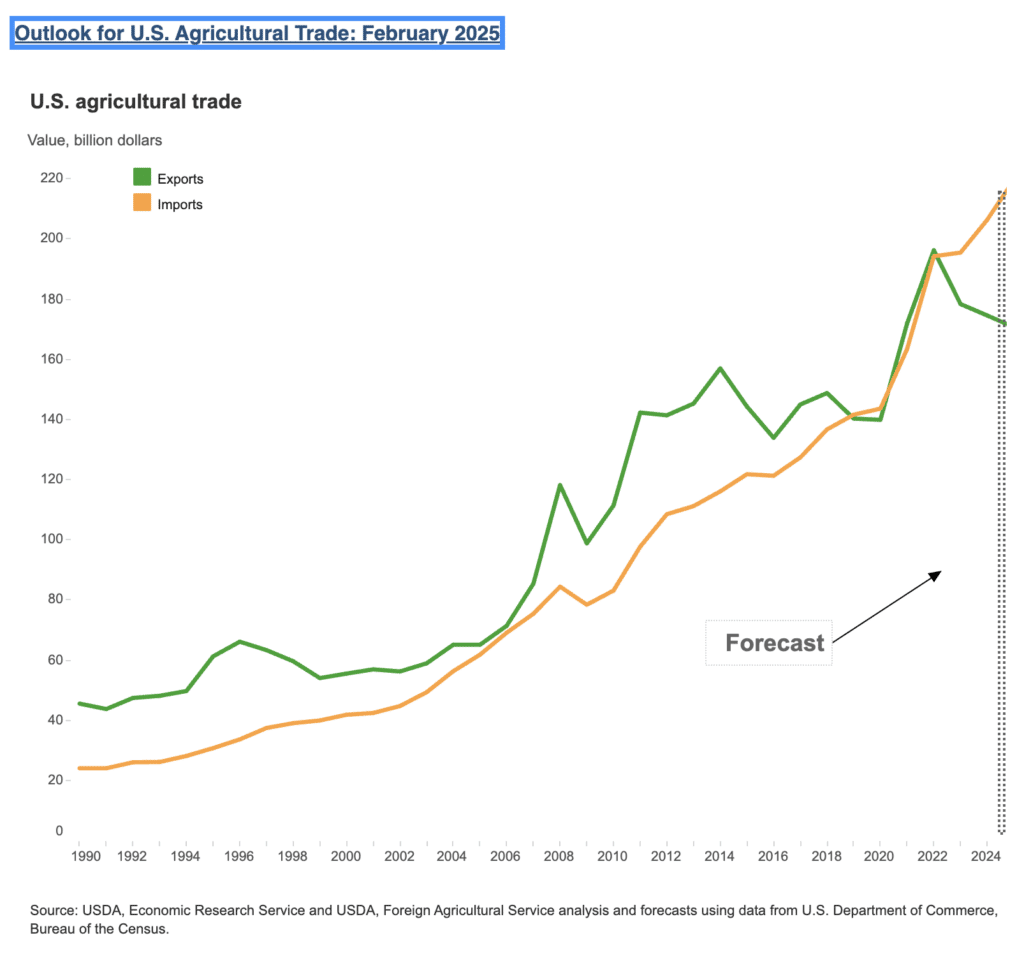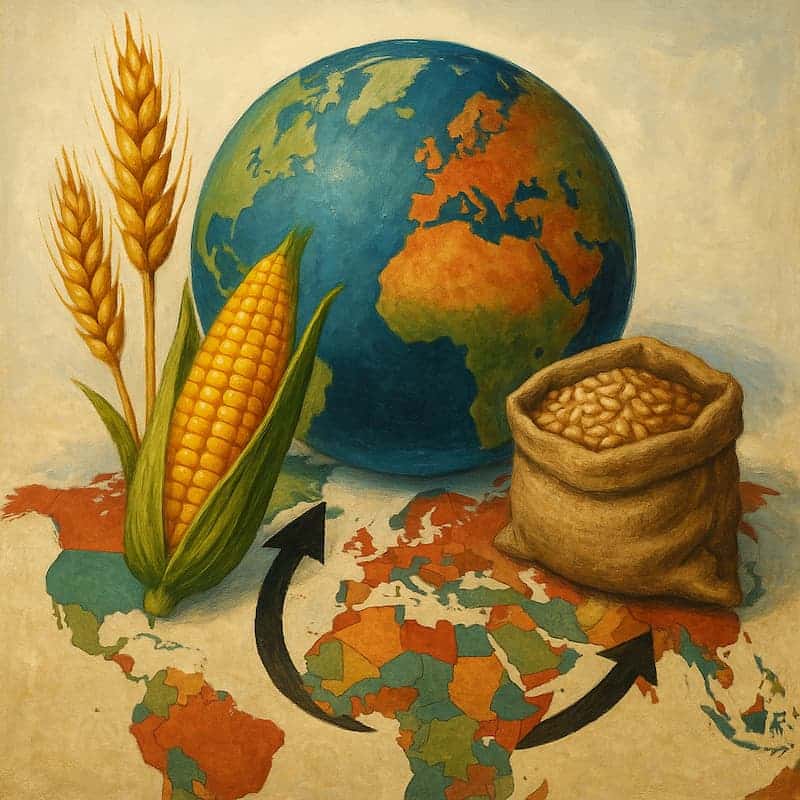The US trade wars started by focusing on countries. Here, negotiating positions are unclear, as there are many different products and complex supply chains with mutual dependencies. Here, trade wars can derail the economies of both the U.S. and the countries exporting to the U.S. But trade wars derail governments if their populations face the risk of hunger. It is therefore disturbing that Trump and Vance are now considering shifting their trade wars to target agricultural products. Agricultural supply chains are however also complex, especially over time. Climate change, demographic trends, living standards, fertilizers, and scientific research all play a role.
The US change agenda is enormous ...
Trump has launched his second presidential term at breakneck speed. So far, he and JD Vance are attempting to pick up where his first term left off.

This has first and foremost led to new tariffs on all countries from which the U.S. imports more than it exports. The tariffs are imposed regardless of whether tariffs already exist. Even though these new tariffs are thus officially justified by claims of “unfairness” and “reciprocity,” the real motive is to reverse the U.S.’s rising net imports. Most countries in the world thus currently outcompete the U.S.

Going forward, two elements of the trade wars are especially worth watching: the mechanism and the focus.
... and it is the plan, that foreign countries shall finance the state deficit
The mechanism behind Trump’s envisioned trade wars provides no real winners. Some however lose more than others. That part gives up who sees the abyss first. Trump therefore seeks to target his trade wars on those areas, where he believes the U.S. is strong and the opponent is weak. In such cases, the opponent should in theory give up first.
- Trade agreements normally take many years to develop. For example, the EU’s recent agreement with Mercosur took three decades to negotiate and still lacks full approval from France. This slow pace is the result of, that good trade agreements should stimulate both sides’ natural competitive strengths. They should create “win-win” opportunities, for lack of a better term.
- Trump lacks the time and maybe also the will for such agreements. His trade wars are critical to the U.S. economy in the short term, as his economic policy of tax cuts falls apart unless foreign countries finance. In 2025, the U.S. federal deficit is already approaching unsustainable 7%. Moreover, the DOGE savings fall far short of their targets, and the Fed continues to resist interest rate cuts. All of this worsens the U.S. underfunding.
- The 90-day pause in tariff escalations since April 9 should thus be seen as just that, a pause. The U.S. government needs to raise revenues, and they need to come from abroad. If they come from domestic sources, the U.S. economic outlook may worsen further, at least given the tax structure.

This will not be an easy task, and ...
American companies are expected to build up business inventories during this period so they can withstand future supply chain disruptions. Trump expects that foreign countries, in the meantime, will seek negotiations with the U.S.
If that fails, Trump has promised escalating tariff wars. We saw a dress rehearsal for this when China and the U.S., within a few days in April, outdid each other with “reciprocal” tariffs reaching over 100%.

... it affects the focus of the trade wars, ...
The focus of the trade war was initially on countries. But in late April, it was supplemented by a targeted sectoral tariff on auto parts and industrial products such as steel and aluminium. The main objective was to pressure Canada, Mexico, and Germany into negotiating new trade agreements.
- This shift is significant because it narrows down the focus of the trade war. The more specific the focus, the closer it is to a potential negotiating framework. A country-focused strategy mainly serves to force the counterpart to the negotiating table.
- The more dependent a country’s economy is on exports to the U.S., the more vulnerable it becomes. This applies, for example, to Mexico. However, Mexico exports a very broad range of both agricultural and industrial goods to the U.S. This blurs trade negotiations.
- Conversely, the U.S. bargaining position weakens the more it depends on imports from a country and lacks alternative supply routes. This is the case with deliveries of e.g. advanced chips from Taiwan. As a result, markets expect Taiwan to be among the first countries that will conclude a trade agreement with the U.S. This is reflected in the recent rise in the Taiwan dollar.
- Finally, the bargaining position is blurred when the counterpart’s economy is strong enough to endure a prolonged trade war with the U.S.
Contrary to Trump’s expectations, both the EU and China have gained economic momentum over the past three to six months. The risk of new external adversaries helps bridge mistrust from the past.
- Trump’s focus on China in the tariff war partly builds on speculation that China’s heavily leveraged economy will collapse in the case of a modest drop in exports. So far, much however suggests that the trade war has had the opposite effect. China has long been preparing by diversifying both exports and FDI away from the U.S. Instead, they have strengthened ties with ASEAN, Africa, and South America. In March and April, China also repeatedly encouraged the EU to pursue a free trade agreement.
- Xi Jinping also visited several South American countries in 2024. In addition, BRICS+ has been strengthened since the botched summit in Kazan in October 2024. Xi also visited Malaysia, Vietnam, and Cambodia in April this year.
- Similarly, the EU is currently focused on establishing trade agreements with India and several ASEAN countries. The EU has also responded positively to China's call for free trade negotiations. The economic outlook for the EU has also improved as a result of large-scale rearmament.
- Trump’s focus on China in the tariff war partly builds on speculation that China’s heavily leveraged economy will collapse in the case of a modest drop in exports. So far, much however suggests that the trade war has had the opposite effect. China has long been preparing by diversifying both exports and FDI away from the U.S. Instead, they have strengthened ties with ASEAN, Africa, and South America. In March and April, China also repeatedly encouraged the EU to pursue a free trade agreement.

... that must be concrete to lead to agreements
Therefore, it is worth paying attention to when the U.S. trade wars become product-specific, and which types of products are in focus.
Both Trump and Vance have recently repeatedly mentioned agricultural products as a potential target. Vance has specifically pointed out that U.S. trade in agricultural goods generally possesses the structural characteristics Trump defines as “favorable” for negotiations. These center around simplicity in supply chains and in the final product. However, the U.S.’ actual negotiating position remains unclear, especially toward the countries from which it imports the most agricultural products.
It is yet reasonable to believe that agricultural products will be the focus when the 90-day pause expires in July. The U.S.' actual negotiating position is however unclear, in particular towards those countries, from which the U,S, import the most agricultural products.
U.S. domestic politics reinforces the suspicion. Trump won the election primarily due to support from swing states and the agricultural sector. He now needs to secure their continued backing ahead of next year’s midterm elections. These will determine the congressional majority, making a breakthrough in agricultural trade especially crucial for him.
Agricultural products are mentioned and seem politically obvious ...
- During his first presidential term, Trump achieved his only trade breakthrough with China specifically in this area. At the time, China promised to purchase significantly more soybeans from the U.S. Trump presented this as a major personal negotiating victory.
- It however later proved to be purely symbolic. In practice, China continues to import the bulk of its soybeans from Brazil, with which it has a close alliance. China and Brazil are founding members of the BRICS+, and China has made substantial investments in Brazil through the Belt and Road Initiative. Moreover, the relationship is of strategic importance to China, which is why Xi Jinping visited Brazil in November 2024. This visit likely served as preparation for the current trade war with the U.S., which China has long anticipated.
- Trump’s second presidential term has generally picked up where he fell short of breakthroughs in his first term. This includes, for instance, his failed attempt to purchase Greenland, as well as the ongoing trade wars.
- Trump e.g. marketed his first major trade deal from his first term, the USMCA (NAFTA 2.0) agreement with Mexico and Canada, as a major personal success. In reality, however, the U.S. net imports from Mexico and Canada have increased significantly. In the U.S., these net imports have become especially visible in the public debate concerning agricultural products.
- From Mexico, for example, net imports rose from USD 78 billion in 2018 to 172 billion in 2024, and from Canada they rose from USD 19 billion in 2018 to USD 63 billion in 2024.
- This is the opposite of Trumps aim with the USMCA.
Furthermore, U.S. exports of agricultural products have declined since 2021, while imports have simultaneously increased.

This has led to a net import of agricultural products of 12%. If these two trends can be reversed, Trump will gain a politically straightforward but significant victory. This could secure his continued congressional majority after next year’s midterm elections.
... but is much less simple in practice
Today, the U.S. primarily net imports agricultural products from the countries Trump initiated his trade wars against. These are the very countries the U.S. considered close allies until January 20 of this year.
- The U.S. net import from Mexico and Canada stands at USD 15 billion and USD 12 billion, respectively, and USD 20 billion from the EU.
- The main U.S. agricultural exports are soybeans (USD 25 billion) and corn (USD 14 billion).
- It was particularly U.S. soybean exports to China that declined during 2024. This drop was partially offset by increased exports to Mexico and to Southeast Asian countries such as the Philippines, Vietnam, and India.

In theory, a positive net export of agricultural products could therefore most easily be achieved through increased exports of soybeans to China.
- China’s soybean consumption, for example, remains unchanged; they are simply importing from Brazil instead. But Trump cannot be certain of getting his way with China, as outlined above.
- He therefore needs to simultaneously increase U.S. agricultural exports to Canada, Mexico, and the EU. The sooner he secures this, the more he can politically withstand a scenario in which China continues to retaliate in the trade war, as has so far been the case.
To be continued in the next blog post

